DAILY NEWS ANALYSIS 11 JUNE
Ryots sow seeds of defiance
Topic Important for: General Studies- 2I Agriculture, Biodiversity
Context:
Farmer from Maharashtra protested against the central government decision to ban the Genetically Modified Crops.
|
The issue has gained momentum in the wake of Haryana government accusing two farmers of illegally growing genetically modified brinjal and destroying their crops. |
About:
- ShetkariSanghatana (Farmers’ body) has decided to take the movement across the State in the wake of the ban of HT(Herbicide-tolerant ) BT cotton and Btbrinjal.
- The organisation(sanghatana) is planning to undertake protest of sowing genetically modified crops in all districts of Maharashtra during the kharif season of 2019
|
What is Bt cotton
|
- According to regulation: carrying, storing, selling or sowing of banned GM crops invites a one lakh fine and five years’ imprisonment.
- The use of GM crops in the country is tightly regulated as per:
- Rules for the Manufacture/Use/Import/Export and Storage of Hazardous Microorganisms
- Genetically Engineered Organisms or Cells, 1989 under the Environment (Protection) Act, 1986.
- Almost 90% of all the cotton grown in India is now Monsanto’s Bt cotton (10.6 million hectares in 2011)
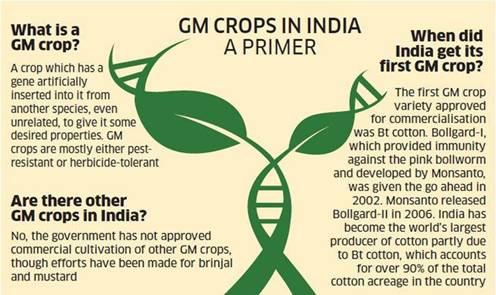
|
Concern:
GM crops are harmful to:
- The environment
- Biodiversity
- To the human body if consumed
- The use of GM crops breaching a commitment to international biosafety conventions such as the Cartagena Protocol.
|
The Cartagena Protocol on Biosafety
The Cartagena Protocol on Biosafety to the Convention on Biological Diversity is an international agreement which aims to ensure the safe handling, transport and use of living modified organisms (LMOs) resulting from modern biotechnology that may have adverse effects on biological diversity, taking also into account risks to human health.
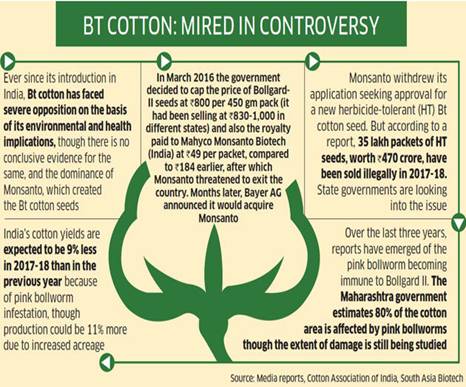 |
Way Forward:
- The central government need to formulate policy that is sustainable and pro environment.
- The concern of Farmer community also needs to address in a holistic manner to maintain their livelihood.
Source Link:https://www.thehindu.com/news/national/ryots-sow-seeds-of-defiance/article27766452.ece
PM Modi to meet Chinese President Xi Jinping, Russian President Vladimir Putin at SCO
Topic Important for: General Studies- 2 I Bilateral, regional and global groupings and agreements involving India
Context:
The prime minister of India will attend the 19th summit of the Shanghai Cooperation Organisation (SCO).
About:
- The 19th summit of the Shanghai Cooperation Organisation (SCO) will be held at the Kyrgyz capital, Bishkek on June 13-14.
- India has not confirmed any bilateral meeting with Pakistan on the sidelines of the SCO Summit.
- Prime Minister Narendra Modi will meet Russian President Vladimir Putin and Chinese President Xi Jinping on the sidelines of the summit.
|
Shanghai Cooperation Organisation (SCO)
Objectives of the SCO:
Maintain and ensure peace, security and stability in the region.
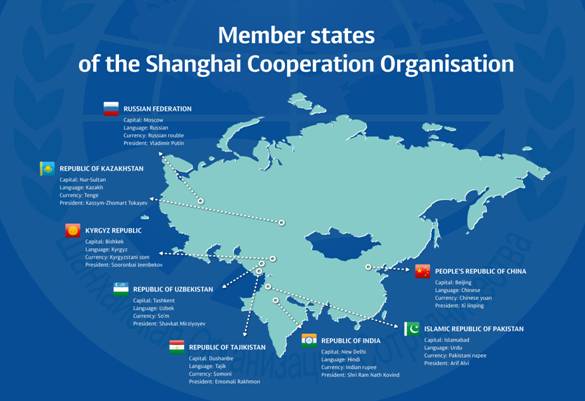 |
Importance for India:
- The summit at SCO will act as the right forum for India to raise the issue of thePulwama terror attack.
- India was satisfied with the participation in the Regional Anti-Terror Structure (RATS).
- India has been participating in tactical drills and counter-terror cooperation with other SCO member countries under the RATS.
- India’s membership of SCO can help in achieving regional integration; promote connectivity and stability across borders Security.
Challenges for SCO:
- The issue of combating terrorism, extremism and separatism, drug and weapons trafficking.
- Apart from being geographically close member countries the grounded and basic issue still remains unsettled.
- National interests and form of government, wealth and culture makes the SCO decision making challenging.
Source Link: https://www.thehindu.com/news/national/modi-to-meet-xi-putin-at-sco/article27766641.ece
MoSPI proposes to use big data analytical tools to improve official statistics
Topic Important for: General Studies- 2 I Important aspects of governance
Context:
The Ministry of Statistics and Programme Implementation (MoSPI) has proposes to set up a 'National Data Warehouse'.
About:
- The Ministry of Statistics and Programme Implementation is formulating a legislative framework under which the National Statistical Commission (NSC) may function with independence.
- The National Statistical Commission (NSC) will also provide holistic guidance for improving the national statistical system of the country.
- The Big Data Analytical tools will help improving the quality of macro-economic aggregates and data.
- The ministry has raised the concern over the statistical reforms are concerned.
|
Note: Recently, The Ministry of Statistics and Programme Implementation approved merging of the Central Statistics Office (CSO) and National Sample Survey Office (NSSO) into the National Statistical Office (NSO).
|
Why big data analytical tools is needed:
- Over the years, there have been increasing demands on the statistical system for the production of relevant and quality statistics.
- The Ministry has been accommodating these demands by optimising the available resources and use of technology.
- The recent merger of CSO and NSSO was aimed at leveraging the strengths of the two organisations so that it can meet the increasing demands.
- MoSPI has been criticised in some sections for the quality of macro-economic data.
Big data analytics: Big data analytics is the use of advanced analytic techniques against very large, diverse data sets that include structured, semi-structured and unstructured data, from different sources and in different sizes from terabytes to zettabytes.
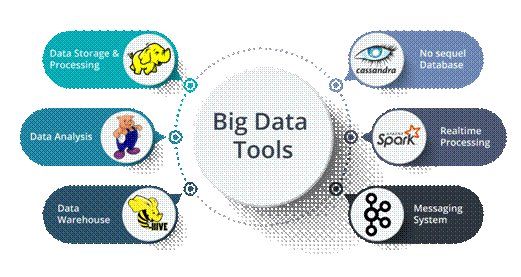
|
What Is Big Data?
|
Way Forward:
- It is important to note that system reforms are an ongoing process and are necessary for ensuring responsiveness to the changing needs of society.
SEBI mulls norms to reward whistle-blowers
Topic Important for: General Studies- 3 I Indian Economy and issues relating to planning
Context:
The Securities and Exchange Board of India (SEBI) has proposed establishing a framework to reward individuals who bring forward instances of violations of insider trading norms.
About:
- The SEBI has proposed that entities that come forward with such information will have to disclose thesource of information and give an undertaking that such information has not been sourced from any regulator.
- The Securities and Exchange Board of India (SEBI) has proposed that if such information leads to a final order by SEBI with a minimum disgorgement of ₹5 crore.
- The reward will be paid from the Investor Protection and Education Fund (IPEF).
- SEBI also plans to establish anOffice of Informant Protection which will be independent of the investigation and inspection wings of the regulatory body.
- The Securities and Exchange Board of India (SEBI) will protect the person who provide information from victimisation in the form of demotion or termination of job
|
Securities and Exchange Board
Power of Securities and Exchange Board:
|
Other Important proposal includes:
- To protect such complainants against victimisation.
- The Securities and Exchange Board has proposed that all listed companies and intermediaries would include in their code of conduct, provisions to ensure that such individuals are not discharged, terminated, demoted or suspended.
- SEBI has also proposed an amnesty for such individuals
- The Securities and Exchange Board has also stated that if a complaint is found to be frivolous, the regulator can initiate actions against the informant.
Source Link: https://www.thehindu.com/business/Industry/sebi-mulls-norms-to-reward-whistle-blowers/article27766525.ece
India may give Pak. its due for action against terror groups
Topic Important for: General Studies- 2 IInternational relations.
Context:
Pakistani authorities had seized several seminaries and educational institutions run by the Lashkar-e-Taiba.
About:
- According to government of India for the first time since early 1990s Pakistan government has begun to take action against India-focussed terror groups and freeze their assets.
- Pakistan was put on the “grey list” by the Financial Action Task Force (FATF) last year.
Note: Pakistan was on the “grey list” of countries of risk between 2012 and 2015 as well.
|
The Financial Action Task Force (FATF)
The Financial Action Task Force (FATF) is an inter-governmental body established in 1989.
The objectives of the FATF are to set standards and promote effective:
|
Why Pakistan Come into action?
- The Pakistan government puts its hard effort to avoid being put on the blacklist.
- Pakistan has seized properties associated with terror groups in Pakistan-occupied Kashmir.
RBI's new framework to expedite resolution of stressed assets: Sashakt committee on bad loans
Topic Important for: General Studies- 3IEconomic Development.
Context:
The reserve bank of India has formulated a new framework to expedite resolution of stressed assets.
Background:
The central government has constituted Project Sashakt headed by PNB chairman Sunil Mehta to address the bad loans problem in India's banking sector.
- Bad loans of up to ₹ 50 crore will be managed at the bank level, with a deadline of 90 days.
- For bad loans of ₹ 50-500 crore, banks will enter an inter-creditor agreement, authorizing the lead bank to implement a resolution plan in 180 day, or refer the asset to NCLT.
About:
- The mandatory norm of inter-creditor agreement allows banks to decide resolution strategy outside the IBC and it will help lenders to accelerate process to resolve stressed assets.
- The Reserve bank of India had issued a circular for resolution of bad loans under which a loan account could be categorised anon-performing asset (NPA).
- The banks were supposed to find a resolution within 180 days or else the case be sent to the bankruptcy courts.
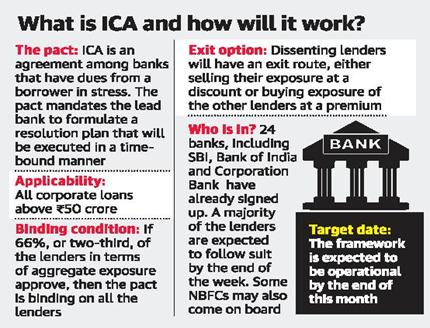
Advantages of Inter-Creditor Agreement:
- The mandatory requirement for an Inter-Creditor Agreement will ensure that resolution efforts can be implemented by building adequate consensus as unanimity.
- The New Framework further lays down some parameters to be included in the Inter-Creditor Agreement including decision-making by:
ü Lenders holding 75% (by value of total outstanding facilities)
ü 60% by number and protection of dissenting lenders.
- The Inter-Creditor Agreement is required to be executed by all lenders covered under the New Framework and asset reconstruction companies.
Way Forward:
- It will offer a transparent market-based solution and are fully compliant with RBI regulations.
- The resolution process would help bring in credible long-term external capital.



1.png)
